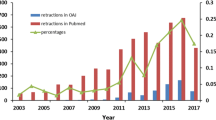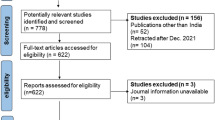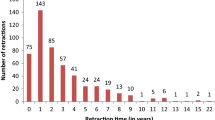Abstract
The number of retracted articles with Chinese authors has raised much attention, but no systematic study has specifically explored the retraction of academic publications by researchers from mainland China. Here, we determined the characteristics of retracted publications from mainland China in the biomedical literature. We searched the Medline database through PubMed and Web of Science to identify retracted publications with first authors from mainland China. Data for 825 retracted studies were included in the analysis. The number and rate of retractions have increased since 1999. We found that 651 retractions were for articles published in journals with relatively low impact factors (< 5). Commonest reasons for retraction were plagiarism (192), errors (159), duplicate publication (143), and invalid peer review (137). Authors of retracted articles were from 28 of the 31 provinces in mainland China. The number of retracted articles from mainland China has shown an increasing trend. Misconduct was the primary reason for retraction. Retracted articles originated from most provinces in China and were published in numerous journals. These findings indicate that misconduct issues are widespread in China. Results of this study highlight the need to take measures to prevent misconduct among Chinese researchers.


Similar content being viewed by others
References
Almeida, R. M., De, A. R. K., Catelani, F., Fontespereira, A. J., & Vasconcelos, S. M. (2015). Plagiarism allegations account for most retractions in major latin american/caribbean databases. Science and Engineering Ethics, 22(5), 1–10.
Ataie-Ashtiani, B. (2017). Chinese and Iranian scientific publications: Fast growth and poor ethics. Science and Engineering Ethics, 23(1), 317–319. https://doi.org/10.1007/s11948-016-9766-1.
Bois, P. R., Izeradjene, K., Houghton, P. J., Cleveland, J. L., Houghton, J. A., & Grosveldz, G. C. (2007). FOXO1a acts as a selective tumor suppressor in alveolar rhabdomyosarcoma. The Journal of Cell Biology, 177(3), 563.
Bu, J. (2013). Retraction analysis of Chinese authors in biomedicine. Acta Editologica, 25(6), 571–573.
Chen, S., Pan, Y., Yao, Q., Yao, L., Liu, Z., & Xiang, L. (2014). Publication pressure on Chinese doctors—Another view. The Lancet, 384(9947), 956.
Cheng, W. H., & Ren, S. L. (2016). Investigation on article processing charge for OA papers from the world’s major countries. Chinese Science Bulletin, 61(26), 2861–2868.
Dyer, O. (2015). Major publisher retracts 43 papers, alleging fake peer review. BMJ: British Medical Journal. https://doi.org/10.1136/bmj.h1783.
Fang, F. C., Steen, R. G., & Casadevall, A. (2012). Misconduct accounts for the majority of retracted scientific publications. Proceedings of the National Academy of Sciences, 109(42), 17028–17033.
Ferguson, C. (2016). One in 25 papers contains inappropriately duplicated images, screen finds. Resource document. http://retractionwatch.com/2016/04/19/one-in-25-papers-contains-inappropriately-duplicated-images-screen-finds/.
Ferguson, C., Marcus, A., & Oransky, I. (2014). The peer-review scam. Nature, 515(7528), 480.
Foo, J. Y. A. (2011). A retrospective analysis of the trend of retracted publications in the field of biomedical and life sciences. Science and Engineering Ethics, 17(3), 459–468.
Haug, C. J. (2015). Peer-review fraud—Hacking the scientific publication process. New England Journal of Medicine, 373(25), 2393–2395.
He, H., & Xia, H. X. (2014). Science citation index papers and research performance assessment:an overview of editing companies. Medicine & Philosophy, 35(10A), 4–7.
Hindawi Publishing. (2015). Hindawi concludes an in-depth investigation into peer review fraud. Resource document. http://www.hindawi.com/statement/.
Hinnerk, F. D. (2017). Journal that holds record for retracted papers also has a problem with editorial board members. Resource document. http://www.sciencemag.org/news/2017/05/journal-holds-record-retracted-papers-also-has-problem-editorial-board-members.
Huh, S., Kim, S. Y., & Cho, H. M. (2016). Characteristics of retractions from Korean medical journals in the KoreaMed database: A bibliometric analysis. PLoS ONE, 11(10), e0163588.
Hvistendahl, M. (2015). China pursues fraudsters in science publishing. Science, 350(6264), 1015.
Ioannidis, J. P., Chang, C. Q., Lam, T. K., Schully, S. D., & Khoury, M. J. (2013). The geometric increase in meta-analyses from China in the genomic era. PLoS ONE, 8(6), e65602.
Jiang, J., Li, J., & Zhou, B. (2016). Analysis on the attitude of title bundled with paper in professional medical staffs. Chinese Hospitals, 20(11), 35–37.
Lei, L., & Zhang, Y. (2017). Lack of improvement in scientific integrity: An analysis of WoS retractions by Chinese researchers (1997–2016). Science and Engineering Ethics. https://doi.org/10.1007/s11948-017-9962-7.
Leopold, S. S. (2016). Editorial: CORR’s new peer-reviewer tool—Useful for more than peer reviews. Clinical Orthopaedics and Related Research, 474(11), 2321–2322.
Liao, Q. J., Zhang, Y. Y., Fan, Y. C., Zheng, M. H., Bai, Y., Eslick, G. D., et al. (2017). Perceptions of Chinese biomedical researchers towards academic misconduct: A comparison between 2015 and 2010. Science and Engineering Ethics. https://doi.org/10.1007/s11948-017-9913-3.
Luo, J., Jiang, P., Li, S. F., & Wu, Y. C. (2016). Investigation and consideration on the value cognition of SCI papers in hospitals. China Modern Medicine, 23(35), 162–164.
Mara, H. (2014). Copycat papers flag continuing headache in China. Resource document. http://www.sciencemag.org/news/2014/10/copycat-papers-flag-continuing-headache-China.
McCook, A. (2016a). How fake peer review happens: An impersonated reviewer speaks. Resource document. http://retractionwatch.com/2016/11/15/more-details-on-the-bmcspringer-retraction-ring-an-impersonated-reviewer-speaks/#more-46134.
McCook, A. (2016b). Ever heard of China’s “five don’ts of academic publishing?”. Resource document. http://retractionwatch.com/2016/10/20/ever-heard-of-chinas-five-donts-of-academic-publishing/#more-45364.
McCook, A. (2017). Can a tracking system for peer reviewers help stop fakes? Resource document. http://retractionwatch.com/2017/06/23/can-tracking-system-peer-reviewers-help-stop-fakes/#more-50733.
Moiwo, J. P., & Tao, F. (2013). The changing dynamics in citation index publication position China in a race with the USA for global leadership. Scientometrics, 95(3), 1031–1050.
Office of Research Integrity. (2012). Findings of misconduct in science/research misconduct. Resource document. http://grants.nih.gov/grants/guide/notice-files/NOT-OD-11-084.html.
Plagiarism Watch. (2016). Eight new Chinese-authored papers published in four journals added to the scandal of “Working Hand in Glove: Scientific Ghostwriting Company and the Predatory Journal Targeting Chinese Authors”. Resource document. http://plagiarismwatch.org/?p=1844.
Pupovac, V., & Fanelli, D. (2015). Scientists admitting to plagiarism: A meta-analysis of surveys. Science and Engineering Ethics, 21(5), 1331–1352.
Qi, X., Deng, H., & Guo, X. (2016). Characteristics of retractions related to faked peer reviews: An overview. Postgraduate Medical Journal. https://doi.org/10.1136/postgradmedj-2016-133969.
Qi, X., Ren, W., Liu, L., Yang, Z., Yang, M., Fan, D., et al. (2013). Prevalence of covert duplicate publications in Budd-Chiari syndrome articles in China: A systematic analysis. The American journal of medicine, 126(7), 633–639.
Rees, M. (2015). COPE statement on inappropriate manipulation of peer review processes. Maturitas, 80(4), 339.
Scott-Lichter, D., & Editorial Policy Committee. (2012). CSE’s White paper on promoting integrity in scientific journal publications. Using Anonymous Reviewers: Critique of the Process. Resource document. https://www.councilscienceeditors.org/resource-library/editorial-policies/white-paper-on-publication-ethics/2-3-reviewer-roles-and-responsibilities/#234.
Steen, R. G. (2011). Retractions in the scientific literature: Do authors deliberately commit research fraud? Journal of Medical Ethics, 37(2), 113–117.
Steen, R. G., Casadevall, A., & Fang, F. C. (2013). Why has the number of scientific retractions increased? PLoS ONE, 8(7), e68397.
Stretton, S., Bramich, N. J., Keys, J. R., Monk, J. A., Ely, J. A., Haley, C., et al. (2012). Publication misconduct and plagiarism retractions: A systematic, retrospective study. Current Medical Research and Opinion, 28(10), 1575–1583.
Tian, X., & Song, G. M. (2015). China’s medical research integrity. The Lancet, 386(10002), e17.
Tucker, J. D., Chang, H., Brandt, A., Gao, X., Lin, M., Luo, J., et al. (2011). An empirical analysis of overlap publication in Chinese language and English research manuscripts. PLoS ONE, 6(7), e22149.
Wager, E., Barbour, V., Yentis, S., & Kleinert, S. (2009). Retractions: Guidance from the Committee on Publication Ethics (COPE). Maturitas, 64(4), 201–203.
Wager, E., & Williams, P. (2011). Why and how do journals retract articles? An analysis of Medline retractions 1988–2008. Journal of Medical Ethics, 37(9), 567–570.
Yuan, H. F., Xu, W. D., & Hu, H. Y. (2013). Young Chinese doctors and the pressure of publication. The Lancet, 381(9864), e4.
Zeng, W., & Resnik, D. (2010). Research integrity in China: Problems and prospects. Developing world bioethics, 10(3), 164–171.
Zhang, Y. (2010). Chinese journal finds 31% of submissions plagiarized. Nature, 467(7312), 153.
Zhang, C. J., & Zhu, Y. (2016). China’s graduate students need better education in scientific writing and publishing. Journal of Zhejiang University Science B, 17(5), 409.
Acknowledgements
This work was supported by Natural Science Foundation of Hainan Province (20168359). The authors would like to thank Medjaden Bioscience Limited that help editing and proofreading this manuscript.
Author information
Authors and Affiliations
Corresponding author
Ethics declarations
Conflict of interest
The authors declare that they have no conflicts of interest.
Rights and permissions
About this article
Cite this article
Chen, W., Xing, QR., Wang, H. et al. Retracted publications in the biomedical literature with authors from mainland China. Scientometrics 114, 217–227 (2018). https://doi.org/10.1007/s11192-017-2565-x
Received:
Published:
Issue Date:
DOI: https://doi.org/10.1007/s11192-017-2565-x




